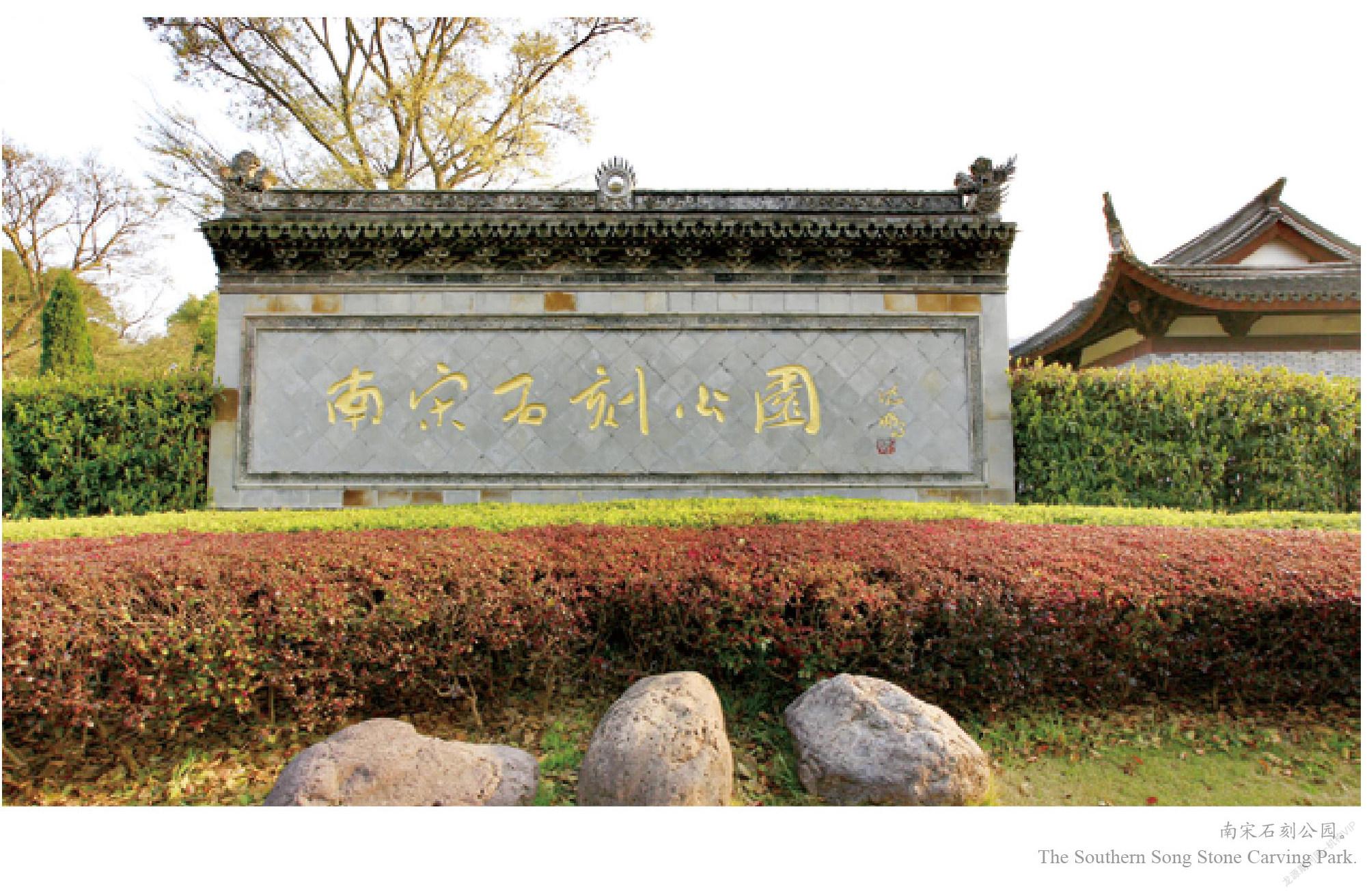南宋文化与东钱湖石刻
2021-12-08刘平平
刘平平



2001年6月25日,国务院公布了第五批全国重点文物保护单位文件(国发(2001)25号),号称“江南兵马俑”的东钱湖南宋石刻榜上有名,从而为其增添了一项全国最高等级的文物保护政策。这是继1976年鄞县人民政府对东钱湖区域发现的大量石刻进行田野调查、1982年公布为县级文物保护单位、1997年浙江省人民政府把东钱湖南宋石刻公布其为省级重点文物保护单位后的最新文物保护举措。在这个名不见经传的东钱湖畔,怎么会出现这样大数量的高等级历史文物呢?带着这个疑问,我们踏上了去东钱湖的“寻宝”之路。
东钱湖位于宁波市东南面,距市区约十五公里,系浙江省最大的天然淡水湖。郭沫若先生曾称誉东钱湖为“太湖气魄 西子风韵”。
东钱湖周边群山映翠,八十一山岭环抱,七十二溪水流注,湖面烟波浩渺,七堰九塘环布四周,因山生水,天水相繞,似一幅泼墨山水画,让人情怡心舒。
南宋石刻公园是我们此行的主要目的地。它位于东钱湖上水下庄黄梅山麓,公园的广场柱子上镌刻着一副气势浩大的对联“北有秦陵兵马俑 南有南宋石刻群”,让人不禁遐想,这个“江南兵马俑”到底是个什么样的存在呢?
1993年12月初,来自全省各地的一些宋史、考古、美术等方面的专家齐聚东钱湖,对在此发现的大量墓室神道仪仗石刻进行了认真细致的专业考察和鉴定,经过反复比较和检验,最终确认这些石刻多数是属于距今近800年的南宋时期的石作物。在此之前,大家都认为南宋墓室神道仪仗石刻极少,长江以南更是罕见。东钱湖畔发现的这些南宋石刻,是我国目前唯一发现的南宋时期规模最大、数量最多、保存最全、雕刻最精的神道石刻,是南宋文化留在宁波的浓重历史遗迹,它填补了我国南宋时期文物考古史、美术史、服装服饰史、雕刻艺术史的研究空白。
东钱湖发现的南宋石构件由两大类组成:1.石构建筑;2.石雕群像。石构建筑主要由石享殿、石享亭、石牌坊、石椅子、石笋、石鼓等组成;石雕群像主要由文臣、武将、立马、蹲虎、跪羊等组成。石雕群像在石作行业里属于花石作,东钱湖南宋石雕像的特点在于:造型端庄、体量适度、表情含蓄、形象生动、内涵丰富。南宋石刻公园内安置着南宋石刻百余具,占整个东钱湖区域已发现的南宋石刻数的约二分之一,园内还基本完整地保留着两个南宋古墓室,均系全国重点文物保护单位,分别为史渐墓(太师齐国公、参知政事)和史涓墓(中散大夫)。
石刻最早是远古人类的文明记忆承载体,石作文化作为一种文化形态,以石造物为具体载体来反映某个历史时期的思想意识、艺术认知、时代特征、制作工艺等,极具可信度和历史价值,它对南宋王朝某些具体规制和意识形态及艺术构思风格进行了系统的形象记录,佐证和丰富了当时的历史文化资料。
我们对这些石雕群像进行了仔细探索和全面研究,知悉那些石雕像背后的文化含义,文臣、武将、立马、蹲虎、跪羊,分别代表着“忠、勇、义、节、孝”。南宋王朝实行的是抑武扬文、文人治国的理政体系,朝廷有意识地压制军人对施政体的作用,并对军队进行严格的控制。有句话叫“军无常将,将无常兵”,平时朝廷把军队的高级将领与兵卒分割开来,再加上军队缺乏最主要的作战装备——战马,导致军队无法发挥最佳的战斗效能,国家常年经受外侵困扰,影响国力强盛。所以墓室神道仪仗石刻的设置中,文臣立首位。朝廷明文规定,同等官职的文武官员相遇,武官必须先向文臣行礼。神道石刻的文臣给它辅予一个“忠”的含义,寓意对朝廷和皇帝忠诚;武将的含义是“勇”,寓意保家卫国,勇猛善战。立马的含义是“义”,引用我国传统文化中“马有垂缰之义,狗有湿地之举”的义马垂缰救主典故。蹲虎的含义是“节”,宋人曾观察到,自然界虎死而不倒,谓此山中之王,临死时尚能保持王者之气节。跪羊的含义是“孝”,宋人对自然之观察尤为细致,他们发现自然界有两种动物蕴含人间之节孝大义,一是乌鸦,小鸦觅食反哺窝里老鸦,谓之“乌鸦反哺”;另一种则是羔羊跪吸母乳,寓意对母亲的敬爱和体恤。
另一方面,我们也对石雕的纹样装饰进行了一定程度的对比研究,可以推断各类石刻的衣饰纹样在不同时期的演化发展状况。我国早在北宋时期就对建筑业的工程技术进行规范,制订了全世界最早的建筑行业规范性标准体系,著作有《营造法式》。我们在东钱湖南宋石刻的雕像上发现了十余种纹样,在《营造法式》中可以明确找出各种对应标示的吉祥图案,如云纹、水波纹、宝相纹、卷草纹、几何纹、缠枝纹、海花纹、瑞兽纹、山石树木纹等。再如文臣中的帽式、武将的胄甲、武器等装饰配件与宋人史志记载和绘画所表现的完全一致,精雕技艺精湛,几组马匹鬃毛雕刻细腻,皮下血管若隐若现,写实手法妙不可言。
言归正传,为什么在东钱湖畔会出现大量的南宋石刻?原来南宋时在东钱湖出了一个史氏家族,这个家族早在北宋时期就分别从江苏、湖州等地迁移至明州(今宁波),其中第二代史成迁居至东钱湖下水,这个家族渔樵耕读、辛勤劳动的同时,读书教学从不懈怠,南宋时族人史才进入仕途,曾任职至参知政事(副宰相)高位,后从第四代史浩担任宰相起,家势日益兴旺,整个家族出了三个宰相封二王,五个尚书,十一个公侯,十个男爵,七十二位进士。历经宋高宗、宋孝宗、宋宁宗、宋理宗。宋史曾有记载“满朝朱衣贵,净是四明山”,宁波地方志记载曰“满朝文武,半出史门”“北宋说的是杨家将,南宋看的是史家相”。根据当时宋朝规制,封侯入相,允许在其墓室神道两旁设置仪仗石刻。
东钱湖是史氏家族的祖居地、发家地,虽然后面那些当官的后人都迁入明州城内月湖旁筑室造楼,但根据国人传统习俗“叶落归根”,所以都把身后归宿地放到了东钱湖。至今我们发现在东钱湖畔的南宋古墓有五十余座,多数都属史氏族人,前文介绍的在南宋石刻公园内的两座南宋古墓都姓史,史氏家族成员。
史浩、史彌远、史嵩之,这三位史姓宰相、史氏族人,活跃南宋朝廷五十余年,也给东钱湖遗留了不少地方文化资源,例如坐落在下水西村的“八行堂”,就是史氏家族的祠堂。其中,史氏先辈史诏奉行“孝、友、睦、姻、任、恤、中、和”八行义举,惊动民官,郡守荐举,史诏固辞不赴,后屡荐不应,宋徽宗赐号史诏为“八行高士”。据说过去宁波人过中秋都在八月十六,比标准日子农历八月十五迟了一天,也是与史浩有关,一个人改变了一个地区的风俗习惯,足可见史氏家族对当地文化、民风民俗的深远影响。
(作者系南宋石刻公园原负责人)
The Song Dynasty Culture and the Dongqian Lake Stone Carvings
By Liu Pingping
On June 25, 2001, Chinas State Council announced the fifth batch of “Major Historical and Cultural Site Protected at the National Level”, among which was the site of the Dongqian Lake stone carvings. The stone carvings, regarded as the “Terracotta Warriors of Jiangnan [South of the Yangtze River]”. The announcement was the latest cultural relics protection measure for the site. The Yinxian Peoples Government first ordered a field survey in 1976 after a large number of stone carvings were found in the Dongqian Lake area. In 1982, the site was made a county-level cultural relics protection site, before the Zhejiang Provincial Peoples Government designated it a key cultural relics protection site at the provincial level in 1997.
Why is it that in Dongqian Lake, a not-so-well-known place, were there such important historical relics in such a great quantity? With this question, I set out “treasure hunting” around the Dongqian Lake.
Located in the southeast of Ningbo city, Dongqian Lake is about 15 kilometers away from the urban center. It is the largest natural freshwater lake in the province of Zhejiang. Guo Moruo, a leading Chinese author in the 20th century, once praised it as “similar in spirit to the Taihu Lake and as charming as the West Lake”. Indeed, surrounded by plenty of mountains, hills, rivers, dykes and embankments, the Dongqian Lake looks more like a traditional Chinese painting.
The Southern Song Stone Carving Park, as the site is now called, is my destination, situated at the Shangshuixia village on the side of Huangmei Mountain. Standing in the square of the park are the pillars, on which a couplet was engraved: “The North Has Terracotta Warriors; The South Has Southern Song Stone Carvings.”
In early December 1993, a team of experts on Song history, archaeology and arts from all over the province gathered in the Dongqian Lake area, and conducted a thorough and meticulous investigation on the many stone carvings and sculptures found in the ceremonial burial chamber here. After repeated comparison and appraisal, they determined that most of them were stone carvings of the Southern Song dynasty (1127-1279) dating back nearly 800 years.
Prior to the discovery, it was believed that stone carvings serving for the “sacred way” in the Southern Song tombs were rare, especially so in the Jiangnan region. They are now deemed the largest in scale, the best-preserved and the most exquisite sacred-way stone carvings of the Southern Song period. These relics are not only the physical imprint of the Southern Song culture in Ningbo; they have also filled the research gap on the archeology, art history, clothing history and sculpture history of the period.
The Dongqian Lake stone carvings comprise of two categories: stone architecture and stone statues. The stone architecture is composed of stone halls, stone pavilions, stone archways, stone chairs, stalagmites and stone drums, among others. The stone statues include those of scholar officials, military officers, standing horses, squatting tigers and kneeling sheep. In the Southern Song Stone Carving Park are 100 or so of these stone carvings, half of the total that have been discovered. Two well-preserved tombs — one belonging to Shi Jian (1124-1195) and the other belonging to Shi Juan (1120-1202), both high-ranking officials of the Southern Song dynasty — are also in the park.
Stone carvings carry the memories of ancient human civilizations. Stone carving culture takes the shaping of stones to reflect the beliefs, artistic perceptions and production technologies of a certain period, which is of reliable historical value. The Southern Song stone carvings are no exception. They are a systematical record of some of its rules and customs, its ideology and artistic style.
The statues, for instance, hold important symbolic meaning. Scholar officials, military officers, standing horses, squatting tigers and kneeling sheep represent loyalty, bravery, righteousness, integrity and filial piety respectively. In the Southern Song, civil officials enjoyed a higher status than their military counterpart, as the imperial court deliberately suppressed the influence of the army. Therefore, statues of scholar officials were place in front of those of military officers in the tombs. For the animals, their designated symbolic traits were believed by the Song people to be closely related to their nature. For example, a lamb kneeling to suck its mothers milk showed respect to ones mother.
On the other hand, a comparative study on the patterns of the stone carvings has shown their evolution and development throughout the Song dynasty (960-1279). In the Northern Song period (960-1127), China already issued the worlds first set of building standards titled Yingzao Fashi (Treatise on Architectural Methods or State Building Standards). The 10-odd patterns on the Dongqian Lake stone carvings, such as clouds, water ripples, rocks and trees, can all be found in Yingzao Fashi, marked as auspicious patterns. The hat styles of civil officials, the armors and weapons of military officers seen on the stone statues are also completely consistent with historical records and paintings, and the carving skills were second to none.
Then again, why did they appear around the Dongqian Lake? It is down to a notable local family, the Shi clan. Originally living in places like Jiangsu and Huzhou, they moved to and settled in Mingzhou (present-day Ningbo) during the Northern Song era. One of the second-generation settlers, Shi Cheng, came to Xiashui village around the Dongqian Lake, working hard on farming and fishing, and paying equal attention to family education. Later, Shi Cai (1083-1163) would become the first in the family to take up an official in the Southern Song court. Then, since Shi Hao (1106-1194) was appointed the chancellor of the state, members of the Shi family served in so many prominent government positions that it was said “of all the court officials, half are from the Shi family”.
As the “ancestral place” for the family, it was only natural that the Dongqian Lake area would be where these high-ranking officials would choose to retire and live the rest of their lives — “returning to the root”, as dictated by the Confucian traditions. During the process, they built houses and pavilions. It is no surprise, therefore, that the stone architecture, stone statues as well as some 50 tombs found near Dongqian Lake were mostly connected to members of the Shi family.
